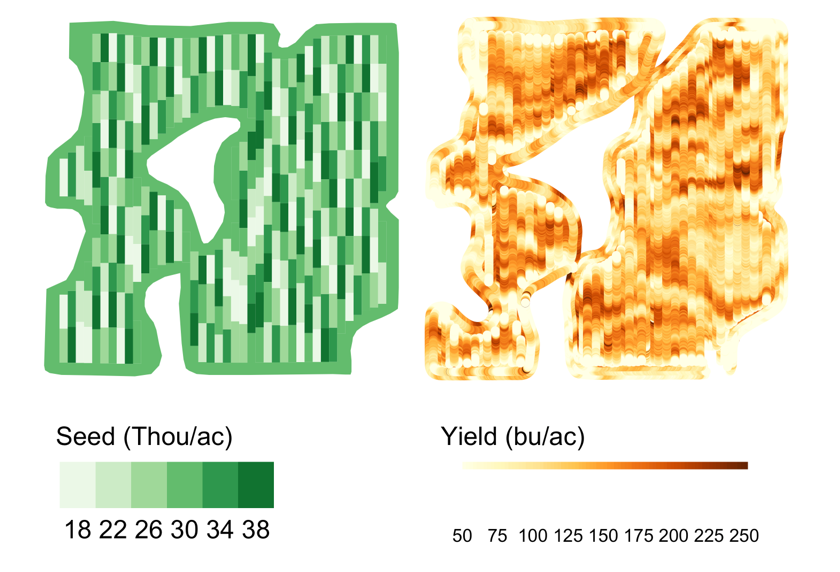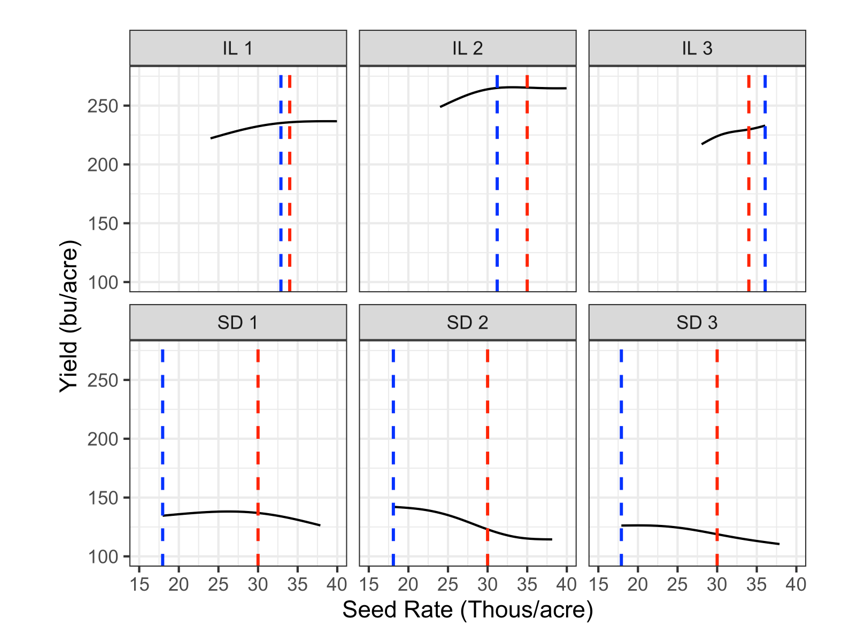Cornhusker Economics April 3, 2024
Learning About Optimal Corn Seed Rate Management Via On-Farm Experimentation: Are Farmers Over-Planting?
By Taro Mieno, Jaeseok Hwang, and David S. Bullock
In agricultural research, particularly in corn production research, nitrogen management garners significant attention due to its dual impact on farm profitability and environmental health. Excessive nitrogen application can lead to groundwater contamination, affecting drinking water quality, and contribute to the eutrophication of water bodies. However, this blog post shifts the spotlight to another critical aspect of corn production: seed rate management. The cost of corn seed—often higher than that of fertilizer—makes seed rate management a key determinator of a farm’s corn production profitability.
In 2022, the Data Intensive Farm Management project, supported by USDA-NIFA and USDA-NRCS and spearheaded by the University of Illinois, implemented over ten seed rate on-farm experiments in the U.S. This post discusses the findings from six of these experiments (three from Illinois and three from South Dakota), which have been prepared for analysis. Each study utilized a Latin square design to systematically explore the impact of various seed rates on corn yield. The figure below presents a map of the seed rate trial design (left) and yield (right) for one of the South Dakota. The experiment’s targeted seed rates varied from 18,000 seeds per acre to 38,000 seeds per acre. In all of the experiments, the experimental rates were centered on the rate a farmer would typically choose absent the experiment (the “business-as-usual” rate). After merging yield outcomes with the corresponding seed rates applied, we conducted a statistical analysis to decipher the relationship between corn yield and seed rate.

The figure below illustrates the estimated yield responses to seed rate (blue solid line) across six fields, alongside the economically optimal seed rate (blue dashed line) and the business-as-usual seed rate chosen by farmers (red dashed line). In calculating economically optimal seed rate (EOSR), corn and seed prices are set at $5.50/bu and $3.81 per thousand seeds.
In the Illinois experiments, a positive response of corn yield to seed rate was observed, indicating that increases in seed rate corresponded to higher yields. Notably, the seed rates chosen by Illinois farmers were relatively close to their estimated economically optimal seed rates (EOSR), suggesting an alignment between actual farming practices and economic optimization based on the set prices of corn and seeds. But the situation differed significantly in South Dakota. A critical observation is the overall lower corn yield in the South Dakota experiments compared to those in Illinois. Contrary to the Illinois findings, corn yield in South Dakota showed a negative response to increased seed rates. This can be attributed to South Dakota’s generally lower precipitation levels compared to Illinois, likely leading to resource competition among seeds. Such competition could result in diminished nutrient availability per seed, and so negatively impact yield.
These different yield responses to seed rate underscore the importance of considering local environmental conditions, such as precipitation, when determining optimal seed rates. The variation between the farmer-chosen rates and the EOSRs in South Dakota further highlights the potential for economic optimization in seed rate selection to enhance yield outcomes and profitability, especially under varying climatic conditions.

The figure below presents the estimated economic losses that farmers would incur by sticking to their business-as-usual seed rates rather than adopting the estimated EOSR. In the IL experiments, the economic losses attributed to not using the EOSR are relatively minor. Conversely, the economic implications for farmers in SD are starkly different and significantly higher. The increased financial burden in SD is primarily due to the combination of higher seed costs and reduced yields (thereby lower revenue), illustrating a clear case of over-seeding.
These findings have proven especially valuable for the South Dakota farmers, shedding light on the extent of over-seeding practices. While it is critical to note that our analysis is based on a small sample size—only six fields, with three in SD —it nonetheless offers interesting insights into the potential issue of over-seeding in U.S. corn production. Just as important, our study underscores the crucial role of conducting on-farm experiments. Such empirical analyses are vital in verifying whether current seeding rates are economically justified, potentially guiding farmers towards more profitable farming practices.

Acknowledgement: This work was supported by a USDA-NIFA-AFRI Food Security Program Coordinated Agricultural Project, titled “Using Precision Technology in On-farm Field Trials to Enable Data-Intensive Fertilizer Management,” (Accession Number 2016-68004-24769), and also by the a USDA-NRCS Conservation Innovation Grant from the On-farm Trials Program, titled “Improving the Economic and Ecological Sustainability of US Crop Production through On-Farm Precision Experimentation” (Award Number NR213A7500013G021), and by USDA NIFA's Hatch Project 470-362.
Taro Mieno
Associate Professor
Department of Agricultural Economics
University of Nebraska-Lincoln
tmieno2@unl.edu
Jaeseok Hwang
Graduate Student
Univ. of Illinois at Urbana-Champaign
David S. Bullock
Professor
Univ. of Illinois at Urbana-Champaign